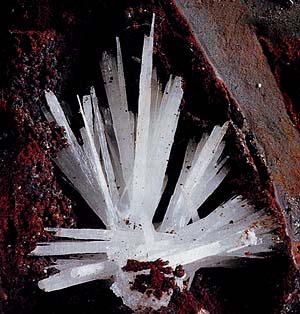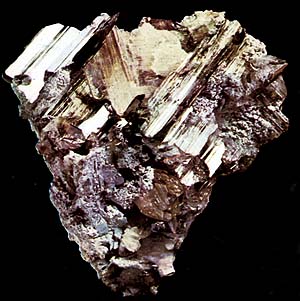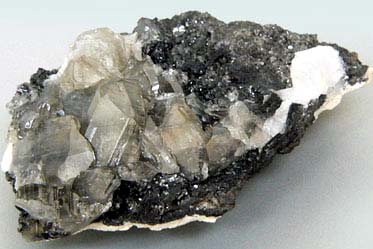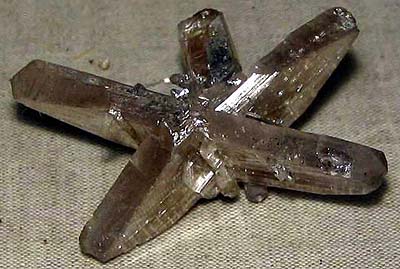Carbonates: cerussite (white lead ore)
 Diagnostic Card.
Diagnostic Card.
On the picture. Needles cerussite goethite lignite mined at the mine Montevecchio (Cagliari).
Pb CO 3
Crystal system orthorhombic
Hardness 3-3.5
Specific gravity 6.5
Cleavage is readily cleaved
fracture conchoidal
Colour colorless, raznookra- Weighted
Color white powder
diamond Gloss

Cerussite - lead carbonate. Gloss fat to diamond, transparent to translucent. Colours: white, yellow, gray, light brown, sometimes black; often colorless. The bar is white. Fracture is uneven to conchoidal. It is very fragile. Cleavage imperfect to clear.
 It is found in the zone of sulfide oxidation polymetallic deposits. Crystals (orthorhombic) tabular, columnar or needle-like, often twinned. Dense granular aggregates, characterized by kidney-shaped and sheaf-like discharge. Important lead ore.
It is found in the zone of sulfide oxidation polymetallic deposits. Crystals (orthorhombic) tabular, columnar or needle-like, often twinned. Dense granular aggregates, characterized by kidney-shaped and sheaf-like discharge. Important lead ore.
"The lead earth" - a kind of earthy cerussite. Black lead ore - a mixture of finely crystalline cerussite with galena. Places manifestations Germany. Czech Republic. England. Zimbabwe, Namibia, Australia, CIS, USA (Ariz., And Colorado).
Frequent counterparts. Diamond Gloss. Crystals suitable for cutting, were met in the Czech Republic, Italy (about. Sardinia), Austria (Bleyberg), Scotland, Namibia (Tsumeb), USA (Pa. And the southern part of the Rocky Mountains). Confused faceted cerussite possible with diamond and other jewelry, colorless and brownish stones.
Cerussite presented elongated prismatic crystals, and is short-and tabular. Occasionally there are dense fibrous masses or earthy addition, stalactites. The crystals are colorless with reflections of light gray color. The powder cerussite white, translucent crystals or transparent with diamond glitter. When exposed to ultraviolet rays observed yellowish luminescence.
Chemical composition. lead oxide (PbO) 83.5% (77.5% lead), carbon dioxide (CoA) of 16.5%. Form crystals. Poevdogeksagonalnye, lamellar, tabular, Shestov. The crystal structure. The same as that of aragonite. Class symmetry. Rombo-bipyramidal - mmm cleavage. Imperfect along the edges of the pyramid. Aggregates. The solid, dense, earthy, columnar.
 Properties. It features a wide variety of crystal shapes and faces. Individual crystals accrued cerussite may have many faces; there pseudohexagonal, prismatic, tolstotablitchatye, spear-shaped, needle tonkotablitchatye crystals (lead-mica combination), as well as aggregates in the form of stars, fans, honeycomb structures, known solid, kidney-shaped, stalked, and bunchy snopo- units, thin smears, powdery and earthy crust ( "lead the land"), heavily polluted). Pseudomorphs galena typical cerussite. As a rule, are twin growths: twins touch prismatic or tabular form, twins sprouting of two tabular crystals, tees penetration with Star habit. Cleavage is imperfect; density of 6.4. Colour colorless, white, gray, yellow, brown, black due to inclusions of galena particles (black lead ore). The ultraviolet light is visible blue-green fluorescence.
Properties. It features a wide variety of crystal shapes and faces. Individual crystals accrued cerussite may have many faces; there pseudohexagonal, prismatic, tolstotablitchatye, spear-shaped, needle tonkotablitchatye crystals (lead-mica combination), as well as aggregates in the form of stars, fans, honeycomb structures, known solid, kidney-shaped, stalked, and bunchy snopo- units, thin smears, powdery and earthy crust ( "lead the land"), heavily polluted). Pseudomorphs galena typical cerussite. As a rule, are twin growths: twins touch prismatic or tabular form, twins sprouting of two tabular crystals, tees penetration with Star habit. Cleavage is imperfect; density of 6.4. Colour colorless, white, gray, yellow, brown, black due to inclusions of galena particles (black lead ore). The ultraviolet light is visible blue-green fluorescence.
Diagnostic features.
Cerussite easily melts. In contrast to other carbonates, it does not dissolve in hydrochloric acid, but it reacts with nitrogen with vigorous effervescence. On this basis it is easy to vary from very like him anglesite. Strong cracks; due to the formation of lead oxide yellow. Behavior in acids. In dilute HNO3 is a rapid release of carbon dioxide. Similar minerals scheelite, celestite, barite, anglesite. Characterized by the formation of twins makes it easy to distinguish them from cerussite.

Cerussite. Madjarovo, Bulgaria. Sample 8 cm Photo:. © VA Sletov.
Origin.
This is a typical mineral deposits of lead oxidation zone. It primary lead minerals (eg galena), subjected to chemical stress and carbon dioxide circulating water, modified, moving into secondary minerals (eg, Anglia, and cerussite). Widely distributed as a typical secondary mineral ore deposits oxidation zones, accompanied by other secondary minerals of lead, zinc or copper, often occurring on the metamorphosis of galena, and anglesite fosgenitu visually represent transformation process.
Mine and application.
Copies cerussite considerable size and crystal clear coming from Tsumeb (Namibia) and New Mexico (USA). Other good crystals found in Broken Hill (Australia), Feniksvil (Pennsylvania) and Leadville (Colorado) in the United States; in Bohemia, Tunisia and Siberia. In Italy, the famous small but very transparent crystals found in the mines and Montevecchio Monteponi (Kalyaritano). Cerussite used to extract lead and silver by-product. As it occurs in the form of a very beautiful crystals that have great value to science and collectibles.
In the old mining areas cerussite development as an important lead ore is not carried out; excellent samples came mainly from deposits of ores in the Black Forest, Rhineland, Westphalia (Germany). Beautiful crystals are found in cavities of porous corroded galena. Transparent, very large crystals come from Namibia and New Mexico (USA); other fields: the Czech Republic, Italy (on Sardinia.), Scotland, Russia (Nerchinsk Yablonoi Mountains), United States (Arizona), Zambia, Australia. Cerussite sometimes found as a tumor on the waste rock dumps from old mines.
Already Ovid was known mineral called "cerussite" (white lead), the name, obviously, was used for many lead compounds. Haidinger in 1845, following the Latin name, introduced the modern name. Mined cerussite as an important lead ore and silver for the sake of common inclusions. Samples of the mineral of interest for every collector. Transparent faceted crystals cerussite considered uncommon in gemstone collectors.

Cerussite (twinning splice). ~ 6 cm. Tsumeb, Namibia. Photo: © AA Evseev.
- Gatchell - "New Almadén snag" - arsenide and antimony sulfide (modern sulphosalts)
- Antimony - toxic metal (semi-metal) are widely used in industry, medicine and engineering
- Zirconium - a rare and non- metal and dangerous jewel in the oxide and salts
- Gold - yellow dangerous and toxic metal -date and accurate digital cable technology
- Sulphur - a golden-yellow toxic substance and a sign of volcanic activity
- Cadmium - a toxic uncirculated unknown wide range of people silvery metal
- Lead - a poisonous gray simulator silver metal and toxic metal snag
- Arsenic - poison classic medieval and modern poisoners and medicine in medicine
Toxic and hazardous radioactive rocks and minerals
** - Poisonous stones and minerals (obligatory check in chemical laboratory + clear indication of toxicity)
** - Radioactive rocks and minerals (obligatory check on a regular dosimeter + ban on the open sale of radioactivity in the event of more than 24 mR / hour + additional measures to protect the population)
Catalog minerals and gems in groups of the world
** - Poisonous stones and minerals
** - Radioactive rocks and minerals


Comments
Commenting, keep in mind that the content and the tone of your messages can hurt the feelings of real people, show respect and tolerance to his interlocutors, even if you do not share their opinion, your behavior in terms of freedom of speech and anonymity offered by the Internet, is changing not only virtual, but real world. All comments are hidden from the index, spam control.